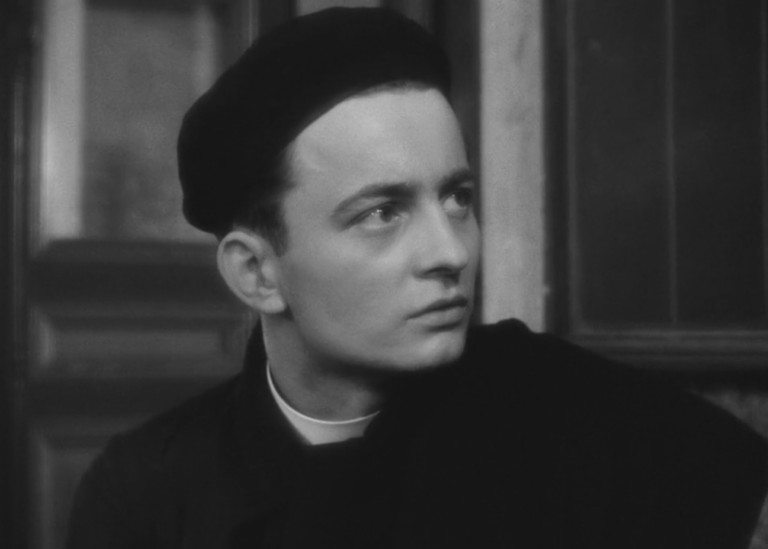The shortest work of Bresson is, in more than a few ways, an interesting microcosm. There abounds an abstract borrowing of narrative and stylistic markers; the episodic dissolves that form an integral part of Pickpocket and Diary of a Country Priest, the unflinching resolve of Fontaine from a Man Escaped and that of Mouchette, and perhaps even the saint-like portrayal of a character rent by the machinations of man (Balthazar is spared the duplicity of language). All of these parallelisms which flash through Joan’s swift, but protracted end portend the evolutions to come and the ones that are temporarily seated in Bresson’s oeuvre. For this, I’d oddly suggest anyone interested in engaging with Bresson to begin with Joan’s trial. If you feel this language of prickly truth coated with a modicum of suggestion to be of interest, you’d find yourself drawn much closer to his longer expositions.
Apart from being a melded perspective trained at the life of a medieval French heroine, the film also stands tall in attesting to the statement that Bresson made about his art eliciting all other views through one view. Joan is a representation, but not merely that of her own sect. Such may be the case from the narrative’s perspective, but she is also a curious reflection of a France at war. Sat high in her tower, her window is penetrated by a stone. She picks it up and tosses it aside with a desultory air. She’s being watched, and she’s aware – the lord is quick to catch a glimpse of her deflated countenance. One evinces, throughout the film, that the hurled stone, the watchful eye, and the sagging defiance are all reasonable traits of a subdued exile-native. She represents the voices of all the people that Bresson needn’t display.
His displays – if one notices Bresson often – are always rigid and importantly, reductive. Delay, his model of Joan, recounted in her experience the days of shooting. “We used only the smallest rooms,” she recalls, “the court is small, the cell is small.” It’s the infertile backdrops of his depictions that reduce the incidence of one’s attention wandering astray. He forcefully feeds you nothing but the character’s efforts to reveal and conceal – and this is another reason why his expositions are short, yet grippingly sharp. Even in open landscapes, he hardly opts for higher or lower ground; if both characters are pressed against the earth, like Seraphita and the Priest from the Diary of a Country Priest, he maintains the neutrality with a grounded angle. Never have I seen a filmmaker more wary of the majestic; he pushes ahead in his forays, maintaining the rigour that commences his first step and concludes the last.
But here, Bresson does something that one isn’t accustomed to. We see the film unfurl after Joan’s mother makes a plea to exonerate her daughter. Ordinarily, the custom is to arrive at a conclusion on Bresson’s principal character at the end of his film. Here, the opposite is the case. Of course, Joan’s true history precedes in the minds of most informed viewers, but even so, a Bressonian depiction doesn’t begin with a clean account of its protagonist. Viewing this with the “sense” of communication that Bresson talks about in his later films, notably L’Argent, it’s evident that he wishes to understand that in this trial, Joan was not at fault for her communication. Unlike Targe from L’Argent, she doesn’t communicate wrongly with the world – the world miscommunicates with her. She’s washed clean of all that’s she accused of before her trial begins; we are to only comprehend the nonplussed distress, valour, and commitment she discloses in her retorts, unaccompanied by sentimentality.
Given the transient nature of the film, the approach that Bresson takes with his dissolves again highlights the rift between his early and late-career. After observing the films that fall on either side of The Trial of Joan of Arc, you begin to see two styles emerge – the episodic and the soldered. Joan’s tale falls within that of the episodic – one where there is no sustained build-up of emotion. Each scene is definitive; without the pattern of highs and lows embedded in these scenes, Bresson maintains a stable metre. She utters her convictions with an unaffected voice and when she is subjected to unjust accusations, Bresson still inhibits histrionics. What ends one scene only vaguely commences another – we move through time and not alongside it. By contrast, if we were to look at Mouchette – which is an ideal example for the soldered – there are sequences that have a direct causal tieback to the ones preceding them. It’s an incremental build-up to the final act, but the approach is still the same; there are no valleys and troughs, only a long, winding river that flows steadily to elicit what one sees in water that isn’t disturbed: a reflection.
Speaking of complication and disturbances, this allows me to wrap up my journey with Bresson here. In his own words, neither prove to be a source of emotion. “When an electrician wants to join two wires,” he softly says, “he starts by stripping them.” Having watched his most seminal works, I’ve continually felt this claim to be true. There are no affected passages, esoteric imagery, and most notably, weighted words. Like a machete against a forest’s vegetation, he’s constantly removing what mists the bridge between the viewer and the character. Not the actor, but the character. At the end of his films, I’ve been moved terribly – but one can hardly see it on my face. It’s almost as if he doesn’t pander to the superficial demands of a movie goer. He cuts straight through and lets you see a spontaneous characterization – one that is directly human without the pointed cues of theatre.
Bresson has been a revelation in the way I see cinema. Contrary to what one is led to believe, a cold focus on the essential doesn’t relegate the medium to that of mere videography. Bresson is amongst the few who wish to see humans the same way that the plentiful photographers of our generation do when they wait hours to see an animal. The difference is that Bresson has managed to create a paradigm and a process that allows to place an architect as a murderer or a young girl as Joan of Arc and watch them react with no comprehension of what has transpired and how they need to adhere to the camera, unlike a conscientious actor. It isn’t exciting, it isn’t exalting; it is, however, profound in the moments where Bresson, the electrician, manages to strip the wires of his narrative and the artifices of his models to create or recreate a world that runs parallel to reality.





